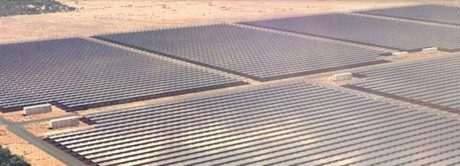Large-scale solar and storage project provides power to Cape York

The first large-scale solar and battery storage to be connected to the grid has started providing power to Far North Queensland homes and businesses.
The Lakeland solar and storage project is located on the Cape York Peninsula, in the vicinity of one of the most remote National Electricity Market substations in Australia. The Australian Renewable Energy Agency (ARENA) committed $17.4 million in funding for the project back in 2016 — a substantial contribution towards its $42.5 million price tag.
Run by solar company Conergy, the grid-connected facility includes a 10.8 MW AC solar farm featuring over 40,000 solar panels alongside a 1.4 MW/5.3 MWh lithium-ion battery. Together, these are capable of providing reliable power to more than 3000 homes and businesses, according to Member for Leichhardt Warren Entsch.
“This is fantastic news for communities in Cape York,” said Entsch. “There is no reason why they should not have access to reliable power simply because of their location.
“The 10.8 MW solar photovoltaic plant and 1.4 MW/5.3 MWh lithium-ion battery will demonstrate providing energy to the local regional community autonomously for several hours.”
“For the people of Lakeland, who live on the fringe of the electricity grid where transmission is generally less reliable, this project helps ensure the lights stay on, even when the sun isn’t shining,” added Minister for the Environment and Energy Josh Frydenberg.
“Combining solar generation and battery storage means energy generated throughout the day can be captured and stored for use when it’s needed overnight or during peak usage times.
“The overall reliance of the community on the grid is reduced and smart controller software manages energy intermittency to create reliable power generation.
“The project will serve as a great example for other regional communities on the fringe of the electricity grid.”
ARENA CEO Ivor Frischknecht said Lakeland is Australia’s first utility-scale co-located solar and battery project to be connected to the grid, helping to show the importance of combining storage technologies with large-scale solar.
“Lakeland is a demonstration for how integrated solar and batteries can together deliver dispatchable supply feeding electricity into the grid when it is needed, whether or not the sun is available at that moment,” Frischknecht said.
“It will also be a test case for deliberate ‘islanding’, where a section of the grid continues to provide power while disconnected from the main grid. This capability will increase the reliability of local supply and pave the way for other fringe-of-the-grid locations.”
Conergy Managing Director Christopher West said his company is excited to be delivering reliable, renewable power to Far North Queensland — a region that is “abundant in solar resource”, he noted, and thus “an ideal place to deliver solar projects like Lakeland”.
Furthermore, while ‘flicking the switch’ to connect Lakeland to the grid, Conergy announced Lakeland Stage II, following approval by Cook Shire Council.
“Once completed, Lakeland and Lakeland II will provide 30 MW of local solar generation, with storage,” said West.
“Imagine powering up approximately 4015 average home air-conditioning units and running them all at the same time for eight hours through the heat of the day.
“That’s the combined production output capacity of Lakeland I and II. And better still, the energy is cleaner and more reliable for the people of Far North Queensland.”
West explained that the use of locally based energy generation in remote areas “reduces power losses caused by lengthy transmission distances from power stations outside the region”.
“Extreme heat in summer can also compromise the efficiency of the network, making local, dispatchable generation even more important,” he added.
Cook Shire Mayor Peter Scott said the council is looking forward to working with Conergy again to deliver even more stable and secure power resources for local residents.
“We are very pleased to be able to approve Lakeland stage two, both for the fact that it again improves supply reliability in our region but also because this is an energy solution which is cleaner and sustainable.”
Conergy ultimately aims to deliver 1 GW of solar and storage for Australia, on the back of its global development of more than 3 GW.
Solar cell achieves world record for efficiency
University of Queensland researchers have set a world record for solar cell efficiency with...
Boral secures grant for cement kiln carbon reduction
The project will reduce process emissions from cement clinker manufacturing by up to...
Vast secures grant to progress SA Solar Fuels project
HyFuel Solar Refinery, a subsidiary of Vast, has been awarded $700,000 through the ASLET...










